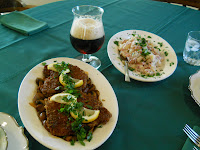 |
| Williams's Bon Chretien: the Barlett Pear |
Gateau aux Poires
Regional Specialty of Burgundy
A regional cake from Burgundy, France, which features apples, pears or apricots in a simple white cake base.
During the annual grape harvest in Burgundy, this type of cake is oft served to the pickers after dinner. Madame Lafarge of
Côte de Beaune, Volnay serves this with
crème fraîche.
(1) We, however, prefer to serve it with more of a flair -- brought to the table covered in flaming sugar and brandy. Total cooking time is 45 min. Makes 1, 9" cake.
Ingredients:
2 pears, We found Bartlett best
(2)
Pantry:
1 c flour
3/4 c sugar
3 t baking powder
3 eggs
1 T oil
Steps:
1) Prepare cake pan with a circle of parchment and greased sides. Wash pears.
(3) Preheat oven to 400 F.
 |
| 2: remove rind with spoon |
2) Quarter pears and remove rind with a spoon. If they are ripe the rind will be very pliable, if they are not ripe use a knife. Dice pears and hold.
3) Place sugar in mixing bowl and beat in the eggs until the batter is smooth. The quantity of beating determines the texture of the cake. Smooth batter will result in a soft cake with fine texture, the converse will result in a coarse, rustic texture.
4) Mix flour and baking powder and then add to egg batter.
5) Once flour is almost incorporated, add oil and finish. Mixing at this stage should be done only as much as necessary.
 |
| 6: incorporate pears |
6) Incorporate the pears swiftly and simply, then pour into pan.
7) Bake for 30 min. Our pastry consultant has firmly admonished that the oven not be opened even a crack for these 30 min. Failure to comply will result in a sunken midriff.
(4)
8) Take out after the 30 min. Free the rim of the cake and invert over a rack. Peel off the parchment and let cool.
 |
| 8: cake in serving position |
9) If serving with
crème fraîche, wait until the time and serve with
crème fraîche. If serving with brandy, coat the top of the cake (the erstwhile bottom) with powdered sugar. When ready to serve, ignite a half cup of brandy and pour over the cake. Bring to the table with the lights dimmed.
Discussion on pears, brandy and flames(5)
The reasons for flaming this cake are several, the flair of presentation (and flame) and the soft, moist warmth flaming imparts. The Barlett pear is otherwise known as the Williams pear which is from the
Bon Chrétien pear brought by St. Francis to the French court in the 1400's. This may be the variety Pliny the Elder calls
Crustumian, as in from the River Crustumius. Williams's version is thought to date from the late 18th century. Such an illustrious background does not warrant the appellation
pyrus communis, but science is inexorable. Nevertheless, the Williams pear is also used to make the brandy
Poire William. This brandy, of course, must be the first choice for flaming this cake. Or, if budget is tighter, a more common brandy may be used to flame the cake and
Poire William served in snifters may accompany it.
When flaming, we've found the best way is to measure the spirit into a Pyrex measuring cup and warm it very slightly in the microwave (remember ethanol boils at 173 F, so if it's lukewarm you can ignite it). Ignite the spirit while holding the cup on an angle. Pour over the sugar-coated cake. Serve.
----------
(1) Hanson, Rosi. Recipes from the French Wine Harvest. London: Seven Dials, Cassell & Co., 2000. p22
(2) Or 2 apples, or 4-6 apricots.
(3) Use ripe pears for a sweeter, more mellow and heavier cake. Use unripe pears for a more tart, crisp and lighter cake.
(4) We verified this by experiment. Opening the oven is fatal to the cake's middle.
(5) Roach, F.A., Cultivated
Fruits of Britain: their Origin and History. Oxford: Blackwell Ltd.,
1985.
 Dogfish Head, Indian Brown Ale
Dogfish Head, Indian Brown Ale















